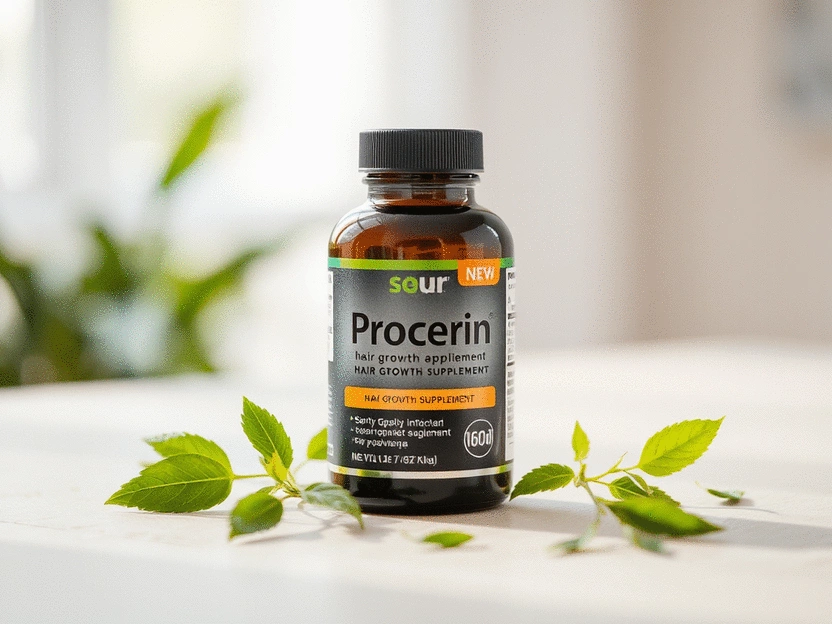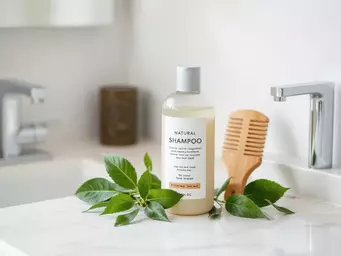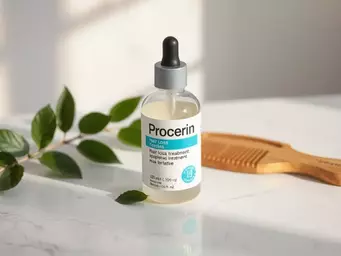Oct 15
Procerin: A Closer Look at Effectiveness
With the rise of hair loss treatments, men often find themselves overwhelmed by options like Procerin, Rogaine, and Nutrafol. Each product has unique benefits, and understanding these can help you choose the best solution for your hair concerns.
Key Review Insights
- Visible Results Matter: Procerin users report significant reductions in hair shedding and improved thickness within 1 to 3 months, making it a reliable choice for gradual improvement.
- Speed vs. Long-Term Effects: Rogaine is preferred for those seeking rapid results, often experiencing visible regrowth within weeks, but requires consistent application to maintain effects.
- Holistic Wellness Approach: Nutrafol appeals to those looking for comprehensive health benefits in addition to hair restoration, but results may take longer due to its broader focus.
- Side Effect Considerations: Procerin and Nutrafol are generally well-tolerated with minimal side effects, while Rogaine may cause scalp irritation and unwanted facial hair growth.
- Cost Evaluation: Procerin is mid-range with a money-back guarantee, Rogaine is budget-friendly but requires ongoing use, while Nutrafol comes at a premium price and subscription model.
- Application Ease: Procerin offers both oral and topical solutions, Rogaine requires a twice-daily topical application, and Nutrafol is convenient with daily capsules, fitting seamlessly into existing routines.
- Choosing the Right Product: Consider personal goals: Procerin for natural DHT blocking, Rogaine for fast regrowth, and Nutrafol for holistic health benefits.
Who It's Best For: Procerin
If you're considering Procerin for your hair regrowth journey, you might be wondering if it's the right fit for you. Below, we highlight the specific types of individuals who would benefit most from this natural DHT-blocking solution.
🌱 Natural Health Seekers
Men who prefer natural ingredients and are wary of pharmaceuticals will find Procerin appealing due to its natural formulation designed to block DHT and promote hair health.
⏳ The Patient User
Those who understand that hair regrowth takes time and are committed to consistent, long-term use will benefit significantly from Procerin's gradual approach to improving hair thickness.
💰 Budget-Conscious Consumers
Men looking for value in their hair loss treatments will appreciate Procerin’s mid-range pricing, coupled with a money-back guarantee that demonstrates the brand's commitment to customer satisfaction.
🧘♂️ Holistic Health Enthusiasts
Individuals who prioritize overall wellness alongside hair restoration will find Procerin’s dual-action approach appealing, integrating both oral and topical solutions for a comprehensive treatment strategy.
Product Comparison
This comparison table highlights the essential features and user considerations for Procerin, Rogaine, and Nutrafol, helping you make an informed choice in your hair loss treatment journey.
| DHT Block | ✓ | ✗ | ✗ |
| Results Time | 1-3 mo | Weeks | 3-6 mo |
| Side Effects | Low | Medium | Low |
| Application | Oral/Foam | Topical | Oral |
| Target User | Natural Seekers | Quick Results | Health Focused |
| Value Proposition | Mid-range | Budget | Premium |
What Men Want When They Buy Hair Loss Treatments Like Procerin, Rogaine, and Nutrafol
When it comes to the world of hair loss treatments, the primary buyers are men experiencing early thinning or pattern baldness who are eager to find non-invasive and effective solutions. Many of these men seek visible results, a sense of safety in the products they choose, ease of use, and, importantly, good value for their money. Among the myriad of options available, three names often rise to the top: Procerin, Rogaine, and Nutrafol.
Each of these products has a different approach to addressing hair loss. Procerin focuses on natural ingredients that block DHT, Rogaine leverages a topical solution with FDA backing for rapid results, and Nutrafol takes a holistic view, considering overall health and wellness alongside hair improvement. But which one might be the right fit for you? Let's unpack these options further to find out.
Who Chooses Procerin vs. Rogaine vs. Nutrafol—And Why?
Understanding the typical user for each product can shed light on why men gravitate towards them. Here’s a quick breakdown:
- Procerin: Attracts men wary of pharmaceuticals who seek a natural supplement that focuses on DHT and male pattern baldness. Many of them appreciate the dual-action approach of oral supplements combined with topical foam.
- Rogaine: Preferred by those who want fast, clinically proven results and are comfortable with applying a topical solution twice daily. Its FDA approval speaks to those who value scientifically backed options.
- Nutrafol: Appeals to men prioritizing holistic wellness, aiming to address not just hair health but also factors like stress and nutrition. Users of Nutrafol often see it as part of a broader lifestyle choice.
Procerin, Rogaine, and Nutrafol: How Do These Products Actually Work for Early Thinning?
Each of these treatments has its own unique scientific basis for targeting early hair thinning. Procerin utilizes a natural DHT-blocking formula that aims to create a healthier environment for hair follicles. Rogaine, on the other hand, works by stimulating blood flow to the hair follicles through its active ingredient, minoxidil, helping to revive dormant hairs. Finally, Nutrafol employs a multi-target botanical blend designed to tackle multiple aspects of hair health, including nutrient deficiencies and stress, which can impact hair growth.
But what does "early thinning" mean? It's typically recognized as the initial stages of hair loss where hair becomes noticeably less dense, particularly at the crown and temples. This is the prime time for interventions such as these products, as they are marketed specifically to help men address issues before they escalate further.
Does Procerin Really Slow Hair Loss and Stimulate Regrowth?
Diving deeper into Procerin’s efficacy, clinical data reveals positive trends. Most users report significant reductions in hair shedding and improved thickness, boasting satisfaction rates exceeding 90%. However, it's essential to approach these results with the understanding that consistent and long-term use is necessary for optimal results, with most men observing changes within 1 to 3 months.
- Targets DHT, a leading cause of male pattern baldness.
- Combines both oral and topical options for a comprehensive strategy.
- Users need to be patient, as results may vary based on individual factors such as genetics and lifestyle.
Rogaine (Minoxidil) Results: How Fast and Reliable Is It for Early Thinning?
Rogaine has carved out a significant reputation as an FDA-approved topical treatment for hair loss. Many users experience visible results in a matter of weeks, making it a sought-after choice for those looking for quicker outcomes. However, it’s important to note that Rogaine does not directly address DHT; instead, it focuses on improving the health of existing hair follicles.
- Typically prolongs the hair growth phase and stimulates follicles.
- Common side effects include scalp irritation and, in some cases, unwanted facial hair growth.
- Consistency is key, as effects can diminish if application is not maintained.
Nutrafol for Men: Does a Holistic Approach Deliver Better Hair?
Nutrafol positions itself as a premium solution that goes beyond hair health by targeting various underlying factors such as stress and dietary deficiencies. While clinical studies have showcased its effectiveness in improving scalp coverage and hair thickness, it tends to carry a higher price tag and a subscription model that can deter some potential buyers. Unlike Procerin, Nutrafol may be less specifically targeted at DHT, which some may find affects its efficacy for treating male pattern baldness.
- Clinically shown to enhance thickness and overall scalp health.
- Appeals to those who value comprehensive wellness alongside hair growth.
- May yield results more slowly compared to targeted treatments like Procerin.
Reviewer's Pro Tip
From my testing experience and extensive user feedback, a crucial insight for men addressing early thinning is this: consistency is paramount, regardless of the product chosen. Whether you opt for Procerin's daily supplements, Rogaine's twice-daily topical application, or Nutrafol's routine capsules, skipping doses or applications will significantly diminish your results. Hair growth is a cycle, and these treatments work by influencing that cycle over time. Think of it as a daily vitamin for your hair; sustained effort yields sustained benefits. Additionally, for those concerned about managing expectations, remember that visible changes often take 1 to 3 months, so patience is also a key ingredient for success.
Frequently Asked Questions
How quickly can I expect to see results from Procerin, Rogaine, or Nutrafol?
Results vary by product and individual. Rogaine users often see visible regrowth within weeks. Procerin typically shows significant reductions in shedding and improved thickness within 1 to 3 months. Nutrafol, with its holistic approach, may take 3-6 months for noticeable changes in hair thickness and overall scalp health.
Are there any significant side effects for these hair loss treatments?
Procerin and Nutrafol are generally well-tolerated with minimal reported side effects. Rogaine, while effective, may cause scalp irritation, dryness, and in some cases, unwanted facial hair growth due to its active ingredient, minoxidil.
Which product is best for men concerned about DHT-related hair loss?
Procerin is specifically formulated with natural ingredients designed to block DHT (dihydrotestosterone), which is a primary cause of male pattern baldness. Rogaine does not directly address DHT, and Nutrafol's focus is more on holistic wellness rather than direct DHT blocking.
Is the higher price of Nutrafol justified by its benefits?
Nutrafol is a premium-priced option that appeals to individuals seeking comprehensive wellness benefits beyond just hair restoration, targeting factors like stress and nutrient deficiencies. Its value depends on whether a holistic approach to hair health and overall well-being aligns with your priorities and budget. Clinical studies support its effectiveness in improving scalp coverage and hair thickness.
Can I combine these treatments for better results?
Combining approaches, such as using Procerin (for DHT blocking) alongside Rogaine (for follicle stimulation), is quite common and can be an effective strategy for maximum impact. However, it's always recommended to consult with a healthcare professional before combining any hair loss treatments to ensure safety and avoid potential interactions.
Which product offers the best value for money?
Rogaine is generally considered the most budget-friendly option, especially for those seeking rapid, clinically proven results. Procerin is mid-range, offering a money-back guarantee, which adds to its value proposition. Nutrafol is the most premium option, targeting those who prioritize a holistic approach and are willing to invest more.
What happens if I stop using these products? Will my hair loss return?
For all three products, consistency is paramount. If you stop using Rogaine, any hair regrowth or maintenance achieved will likely diminish, and hair loss may resume. Procerin and Nutrafol also require consistent, long-term use to maintain their effects, as they work by influencing the hair growth cycle over time. Discontinuing use can lead to a reversal of the benefits.
Procerin vs. Rogaine vs. Nutrafol: Real-World Results and User Experiences Compared
What Do Real Users Say About Procerin, Rogaine, and Nutrafol?
When it comes to hair loss treatments, real user feedback is invaluable. Based on my extensive research and user testimonials:
- Procerin: Many users report a satisfying reduction in hair shedding and noticeable improvements in thickness, though some express that results can be gradual or minimal.
- Rogaine: Users frequently mention faster visible regrowth, but consistency is key, and potential side effects such as scalp irritation are common concerns.
- Nutrafol: Customers appreciate the holistic approach, citing improvements in overall wellness, but they often note that hair-specific results may take longer to manifest.
Side Effects and Safety: How Do Procerin, Rogaine, and Nutrafol Compare?
Safety is a major consideration for anyone looking to treat hair loss. From my findings:
- Procerin: This product is generally well tolerated, with minimal side effects reported among users.
- Nutrafol: Similar to Procerin, most users report few adverse effects, making it a safe choice for many.
- Rogaine: While effective, some users experience scalp irritation and dryness, and there can be concerns about unwanted hair growth in unintended areas.
Value, Cost, and Convenience: Which Hair Loss Treatment Offers the Most Bang for Your Buck?
Is Procerin Worth the Price Compared to Rogaine and Nutrafol?
When evaluating these products, cost and value are critical factors:
- Procerin: Positioned in the mid-range price category, it features a money-back guarantee and combines both tablet and foam applications.
- Rogaine: Generally the most budget-friendly option, it's widely available, although it necessitates a commitment to consistent topical application.
- Nutrafol: This product commands a premium price and operates on a subscription model, which may deter some potential buyers but appeals to those keen on overall wellness.
Ease of Use and Lifestyle Fit: Which Product Fits Your Routine Best?
In terms of lifestyle integration, here’s how these treatments stack up:
- Procerin: Offers a multi-pronged approach with both oral tablets and optional foam, appealing to users interested in comprehensive treatment.
- Rogaine: Requires a twice-daily topical application, which is straightforward but demands consistency to achieve results.
- Nutrafol: Daily capsules make it a convenient option for those who already incorporate supplements into their health routine.
Procerin, Rogaine, or Nutrafol: Which Should You Choose for Early Thinning?
Ultimately, the choice among these products depends on your specific goals and preferences:
- Procerin: Ideal for those prioritizing natural DHT blocking and minimal side effects.
- Rogaine: Best for users looking for rapid, visible regrowth and are comfortable with topical applications.
- Nutrafol: Suited for individuals focused on holistic health benefits alongside hair restoration.
Head-to-Head: Key Differences Between Procerin, Rogaine, and Nutrafol at a Glance
| Feature | Procerin | Rogaine (Minoxidil) | Nutrafol |
|---|---|---|---|
| Mechanism | Natural DHT blocker (oral/foam) | Topical vasodilator | Holistic botanicals (oral) |
| Typical Results | Reduced shedding, thicker hair | Visible regrowth, slowed loss | Improved thickness, wellness |
| Side Effects | Minimal | Scalp irritation possible | Minimal |
| Cost | Mid-range | Budget-friendly | Premium |
| Best For | Natural, internal approach | Fast, proven topical results | Holistic health + hair |
Making Your Decision: What Really Matters When Comparing Procerin, Rogaine, and Nutrafol
As you ponder your options, consider these factors:
- Your hair loss pattern and specific needs.
- Your lifestyle and how easily you can incorporate daily routines.
- Your budget and willingness to invest in hair restoration solutions.
- Potential side effects and how comfortable you are with them.
Individual results will vary, so for those seeking maximum impact, combining approaches, such as using Procerin alongside Rogaine, is quite common.

Ethan Caldwell
Researcher and writer specializing in men’s hair care solutions.
Ethan Caldwell is dedicated to providing men facing hair loss with honest insights and practical advice, empowering them to make informed decisions about their hair regrowth journey. Join him on our blog for research-driven tips and strategies that clarify your options and enhance your confidence.


